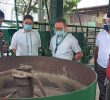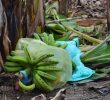With the increasing trend for coconut products’ demand in the world market, farmers are being encouraged to plant more coconut trees.
Pete Alagcan, chair of the coconut industry cluster of the Davao region, said the vast opportunities that the coconut industry can offer must be considered by farmers.
“Just think. At five years old, the coconut tree starts to bear fruit. And the life span of coconut is between 50 to 60 years old. And after two years from planting, there is no need for any more farm inputs,� Alagcan said.
Alagcan said that the average production per hectare of coconut farm is pegged at two metric tons annually.
Moreover, he said the production of copra alone can already give huge income to the farmers especially because only 7 pesos is incurred as farm input in order to produce a kilogram of copra.
To date, copra’s buying price is pegged at an average of 31 pesos per kilogram.
“This is just temporary. By January, the buying price will recover again. The trends are like that. During these months, there is soy and sunflower oil production. By January, production of these other oils will decline and the price of copra will go up again,” Alagcan explained.
During January until June this year, Alagcan said, copra’s buying price was at 40 pesos per kilogram.
Among the primary products derived from coconut are coconut oil, desiccated coconut and copra while by-products include copra meal, activated carbon, coconut shell charcoal and coconut coir and coir dust.
Alagcan said that only 20 percent of coconut production goes to the local market while 80 percent goes directly to the export market.
At the end of 2007, coconut products were among the top ten export commodities of Davao region. In fact, activated carbon/charcoal/dust/briquettes ranked number five with 33.2 million US dollars export value, showing a surge of 14.88 percent as compared to its value a year ago.
Meanwhile, desiccated coconut chips was at number six with an export value of 13.9 million US dollars or 56.18 percent increase from its 2006 figure.
Positioning at number nine was the sub-sector of coconut oil/acid/cake/liquor, a new entrant to the top ten, valued at 7 million US dollars.
“The future of the industry is really bright only if we exploit all the opportunities that we can get out of coconut farming,” he said.
Alagcan cited the Davao industry cluster capacity enhancement project (DICCEP) as one mechanism to foster a more robust outlook for the region’s coconut industry.
“This is one venue where we get to share different information among farmers and processors. We seldom meet as agroup. With DICCEP, we are able to sit down and discuss measures for the development of the local coconut industry. In other words, this is where our collaboration of efforts takes place,” Alagcan concluded.
DICCEP is a project of the Japan international cooperation agency (JICA) and the regional office of the Department of Trade and Industry (DTI) which is aimed at capacitating Davao region’s eight industry clusters, namely, banana, mango, coconut, seaweed, mining, wood, tourism, and information and communications technology (ICT).










